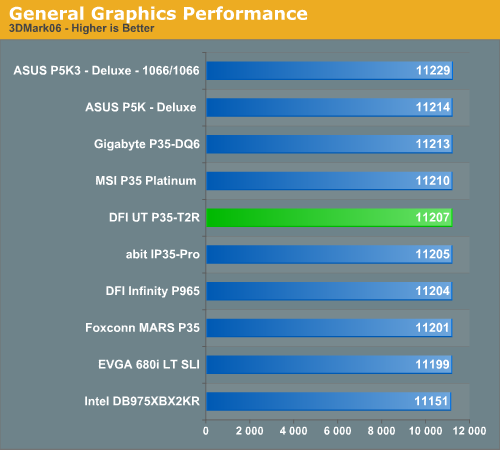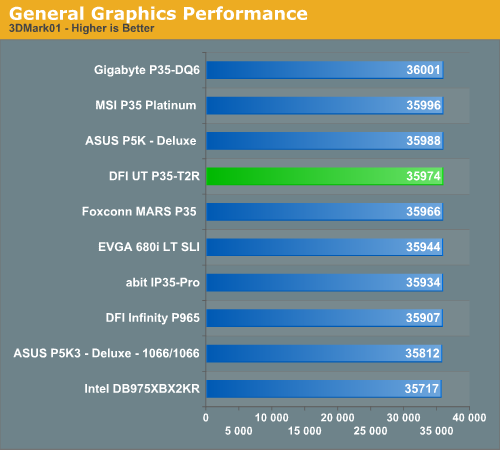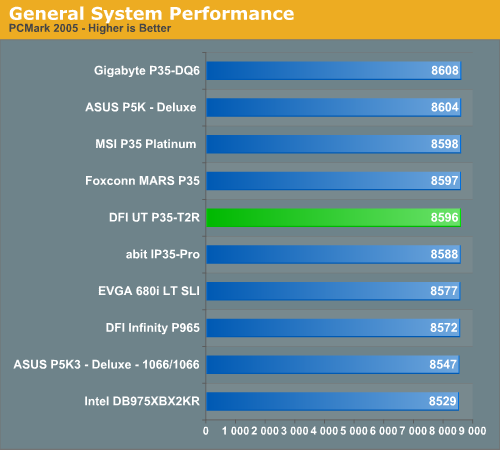DFI UT P35-T2R: Tweakers Rejoice!
by Rajinder Gill on October 18, 2007 2:00 PM EST- Posted in
- Motherboards
Synthetic Graphics Performance
The 3DMark series of benchmarks developed and provided by Futuremark are among the most widely used tools for benchmark reporting and comparisons. Although the benchmarks are very useful for providing apples-to-apples comparisons across a broad array of GPU and CPU configurations, they are not a substitute for actual application and gaming benchmarks. In this sense we consider the 3DMark benchmarks to be purely synthetic in nature but still valuable for providing consistent measurements of performance.


In our 3DMark06 test, the P35 boards are basically even in this test. The DFI board did not exhibit any issues during repeated testing in this CPU/GPU intensive test. In the more memory and CPU throughput sensitive 3DMark01 benchmark we see our DFI board performing well though it's just slightly off the top mark. We typically see this in the DFI boards that are tuned more for overclocking results than stock performance. The differences in performance are not really noticeable in either 3DMark unless you're looking to reach the top of the ORB. That of course requires some serious overclocking as well, and we have a good feeling the DFI was designed to do exactly that with the right setup.
General System Performance
The PCMark05 benchmark developed and provided by Futuremark was designed for determining overall system performance for the typical home computing user. This tool provides both system and component level benchmarking results utilizing subsets of real world applications or programs. This benchmark is useful for providing comparative results across a broad array of Graphics, CPU, Hard Disk, and Memory configurations along with multithreading results. In this sense we consider the PCMark benchmark to be both synthetic and real world in nature, and it again provides for consistency in our benchmark results.

Our PCMark05 scores mimic the results from our 3DMark benchmarks with differences between the boards not exceeding 2%. While this benchmark is designed around actual application usage, we will see if these results mirror our application testing.
The 3DMark series of benchmarks developed and provided by Futuremark are among the most widely used tools for benchmark reporting and comparisons. Although the benchmarks are very useful for providing apples-to-apples comparisons across a broad array of GPU and CPU configurations, they are not a substitute for actual application and gaming benchmarks. In this sense we consider the 3DMark benchmarks to be purely synthetic in nature but still valuable for providing consistent measurements of performance.


In our 3DMark06 test, the P35 boards are basically even in this test. The DFI board did not exhibit any issues during repeated testing in this CPU/GPU intensive test. In the more memory and CPU throughput sensitive 3DMark01 benchmark we see our DFI board performing well though it's just slightly off the top mark. We typically see this in the DFI boards that are tuned more for overclocking results than stock performance. The differences in performance are not really noticeable in either 3DMark unless you're looking to reach the top of the ORB. That of course requires some serious overclocking as well, and we have a good feeling the DFI was designed to do exactly that with the right setup.
General System Performance
The PCMark05 benchmark developed and provided by Futuremark was designed for determining overall system performance for the typical home computing user. This tool provides both system and component level benchmarking results utilizing subsets of real world applications or programs. This benchmark is useful for providing comparative results across a broad array of Graphics, CPU, Hard Disk, and Memory configurations along with multithreading results. In this sense we consider the PCMark benchmark to be both synthetic and real world in nature, and it again provides for consistency in our benchmark results.

Our PCMark05 scores mimic the results from our 3DMark benchmarks with differences between the boards not exceeding 2%. While this benchmark is designed around actual application usage, we will see if these results mirror our application testing.










30 Comments
View All Comments
retrospooty - Sunday, October 21, 2007 - link
Not really. Check this memory test here at AT. http://www.anandtech.com/memory/showdoc.aspx?i=312...">http://www.anandtech.com/memory/showdoc.aspx?i=312...At DDR 2000 at 6X500 CPU the best sisoft standard memory score for DDR3 is 9138 at DDR3 2000 8-7-6-18 ... I get 8871 with my DDR2 1000mhz at 4-4-4-10 with a similar setup on the DFI P35 mobo. DDR3 even at a highly overclocked 2000mhz is hardly faster than DDR2 at 1000 now. I am not going to go to DDR3 until Nehalem is cheap, and DDR3 latency is lower and cheap, 2 more years out.
And PCI-E 2.0 is not going to help for a long time. Like with PCI to AGP, and AGP to PCI-E there is no improvement at all right off the bat. The graphic bus standard is always WAY ahead of the actual cards need for it, 1-2 years at least. We are not even utilizing PCI-E 8x, much less 16x, not even with dual 8800GTX's. Also , PCI-E 2.0 is backward compatible, so I I get the latest greatest Graphic card next year (whatever it is) it will be PCI-E 2.0, but will work fine on PCI-E 1 motherboards.
Raja Gill - Thursday, October 18, 2007 - link
It's one of those things in life, despite having no real logic to it, 'tweaking' actually has a market. DFI took a risk, while this segment does not guarantee large sale volumes, some of the return is made up in a higher profit margin. Without DFI around, some of the more pioneering BIOS options (that actually are of use to Joe blow due to Intel's binning strategy), would never filter thru to other boards. The asking price is high, both Gary and myself recognised this. It has to be said that those who have paid the premium have generally not been dissapointed. In terms of the cascade results, yes, boardss like this and Asus's ROG line are used by the benchmarking community to chase big records, again this is a growing community who pays high dollar for every last drop of performance. We are aiming to satisfy a slightly wider audience with the performance board reviews, by looking at how they will be used, and help out with settings by spending long hours exploring the BIOS functions ourselves, still trying to give a balanced view for JB and some insight to help the benchmarkers decide if the board fits their needs... The bios's on so many of these boards are getting more complex, we hope those who buy the boards can use some of the settings we provide to get a base to work from, (if they need it)..If there's anything else you would like to see added, please let us know....
regards
Raja
Jodiuh - Friday, October 19, 2007 - link
SCREW THEM ALL! I've been drinking and still managed this in under 2 hours.http://img.photobucket.com/albums/v212/jodiuh/DFI%...">http://img.photobucket.com/albums/v212/...0UT%20P3...
Sure I've been able to achieve good results w/ lowly air on the Giga DS3, Asus P5B, DFI Dark, and Abit IP35, but this board:
1. makes oc fun
2. great layout (usb ports towards the front where they should be, shame Abit)
3. great stock cooling, especially for air
4. excellent bios
5. did I mention speed drunk oc? (beer, then 50mhz on the bus)
It's truly a great game. And for about $260, it's a steal. There's no other board that offers this much pleasure. Sure it's $, but then didn't most of you pay $320 for your 6600's? :D
Avalon - Friday, October 19, 2007 - link
Any drunk monkey could OC a decent C2D to 3.5Ghz. I've had plenty of fun OC'ing on my $90 Gigabyte P35 DS3L, which also has a great layout and decent BIOS. It's no DFI, but it gets the job done for $160 less, which is enough money for me to buy a decent video card, 4GB of RAM, 750GB of hard drive space, etc...Don't get me wrong, DFI is by far my favorite motherboard company, and their BIOS tweaking is the best available. However, I will NEVER consider a $260 board a "steal" when the only thing I'll get out of it over a significantly cheaper board is that I have more settings to play with if I feel bored. Fortunately, when I get bored, I load up a game, instead.
cmdrdredd - Saturday, October 20, 2007 - link
Avalon hit it right on the head. Any decent C2D can do over 3.2Ghz and some up close to 4Ghz with proper cooling on $90 boards. There is absolutely NO reason to buy a $260 board this late to market. Not to mention that it is also slower than boards which retail for less money in this review at the settings used.The number of people actually willing to and wanting to use 550Mhz+ FSB is too small to matter.
/end
Jodiuh - Tuesday, October 23, 2007 - link
Most of the 965 board's are a crap shoot for 500fsb, but the 2 p35's I've used had no qualms about this. It's not just getting the OC for me tho. I needed a board that:-doesn't look like rainbow brite exploded on it (Gigabyte DS3)
-doesn't use an AMI bios, hits 500+ FSB easily (Asus P5B Deluxe)
-doesn't crackle (DFI P965-S, Abit IP35 Pro)
-isn't NV (EVGA 680i)
-has usb ports, front panel header, and SATA ports in the far right of the board
-and of course the great stock cooling (uses nuts/bolts), excellent bios, and stable voltages add to the package
There's just no other non-Asus board that did all that right now. Paying another $70 for the extras isn't an issue for a hobbyist that plays w/ his rig.
Acanthus - Friday, October 19, 2007 - link
Yes, we did.And on quad cores, this board does no better than other boards much cheaper than itself.
I am not here to bash DFI, they make great stuff.
The price of admission is too high for this board for quad overclocking from the results i've seen. The FSB limitation appears to be the G0 quads themselves, they all seem to top out at 470-510fsb anyway. The Asus P5K and Gigabyte P35 DQ6 both easily do those speeds on unmodified boards.
customcoms - Thursday, October 18, 2007 - link
Thanks anandtech for providing an overclocking article TRULY worth reading! We needed a motherboard review like this when DFI's original nForce4 boards came out-trying to figure out every bios option, while fun and rewarding, is a very very time consuming process.Its one thing for a reviewer to claim "this board is capable of 500+ fsb speeds" and another COMPLETELY for that reviewer to document virtually every step and every bios option they used to get to that speed. This review is along the lines of the user reviews I normally turn to to verify the components I am interested work as advertised. While the cascade cooling results and extreme price of this board could have been left out, it is good to see a reviewer actually using the hardware in the environment a $300 (or $260, or any board over $200 imo) motherboard is going to be used in.
Jodiuh - Thursday, October 18, 2007 - link
It can be found for $260 from motherboardpro. Comes w/ a nice little LAN carrying harness too.cmdrdredd - Thursday, October 18, 2007 - link
Still too much money. As was said before, it still does not beat some of the boards which have been out for a long time. Sure it looks nice, but for the money spent here, you can buy more memory or the next step up in CPU if you go with a less expensive board.It's late, expensive, and does not have any magic that makes me say "it's better than anything else out there". Even the $90 IP35-E is a good match against this DFI board unless you have to or like to spend hours setting up the bios just so.
It's nice, but like I said too little too late.